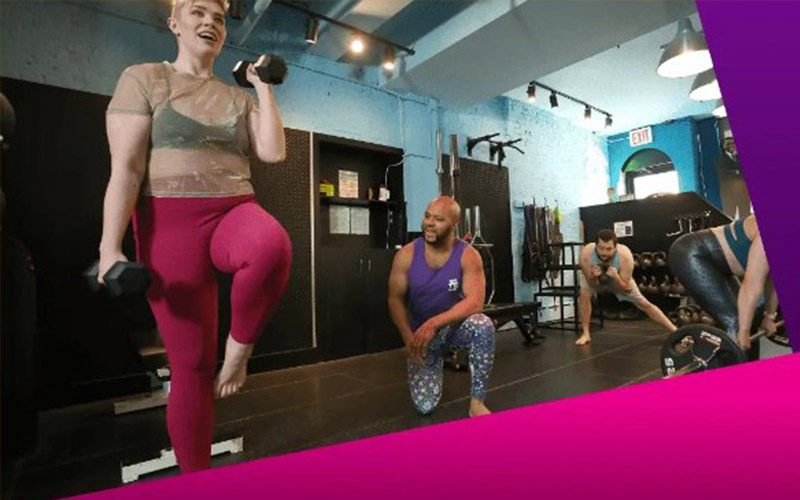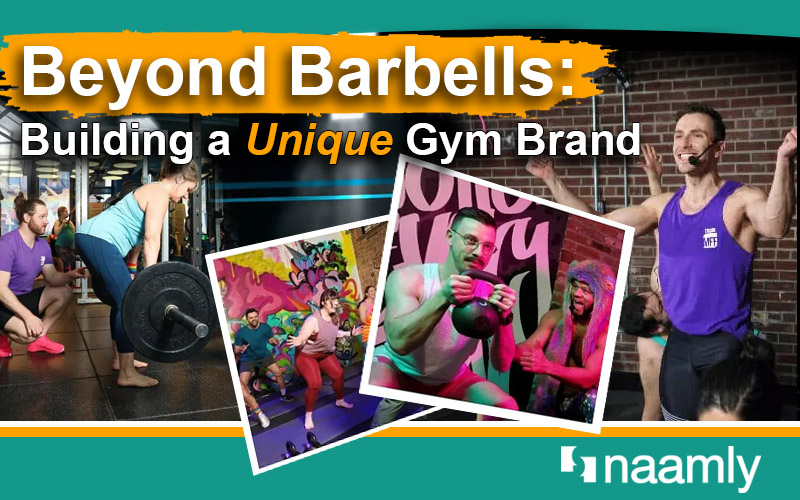Mark Fisher didn’t set out to become a personal trainer or to run a successful gym in New York.
He wanted to be an actor, and was making a pretty good go of things when he stumbled into personal training – mostly for his actor friends at the start.
But before long, things took off and he opened Mark Fisher Fitness near the Broadway theater district as a special place for folks who typically don’t like the gym. The gym branding is infused with fun, goofiness, irreverence, and other zany aspects that appeal to some who appreciate a certain flair.
“The brand became very colorful very quickly because I was unleashed to express myself in a way that felt good to me,” Mark recalls. “I didn’t want to call friends ‘members,’ so we call them ninjas. We have unicorns in there as a spiritual mascot. The place is very colorful and glittery.”

The tagline to sum up all this gym branding? “Ridiculous humans, serious fitness.”
Mark wasn’t trying to be everything to everybody. He knew his target audience. He knew his community. And he knew himself.
It’s been going strong for more than a dozen years now, serving lots of non-theatrical people as well as actors. Mark has also moved into business consulting and is a frequent speaker at conferences.
Your unique gym branding
Gym branding like this can build bonds that create long-term clients and word-of-mouth referrals. You should try to create a gym experience that resonates deeply, attracts loyal members, and boosts engagement with branding hacks like those we’ll discuss here.
But don’t just laugh at the wackiness of Mark Fisher Fitness and say, “That’s not for me!”
True, MFF is its own space, created by an actor for theater people in the middle of Manhattan. Very specific.
Gym branding doesn’t mean you try to be that. But you can learn a lot from what Mark did, no matter who your ideal customers are, where your business is, or how “wild and crazy” you might be.
Consider points like this when thinking about your own gym branding.

1. Know your community well and design your business to serve it. Clearly define your gym’s mission, values, and target audience. Reflect these aspects consistently across all touchpoints, including your logo, signage, website, and social media presence.
2. Communicate constantly. Mark used heavy email output to get his message out initially. You can also spread the word on social media, on your blog, and in your own email newsletters. Seek member and prospect input – and reply to it.
3. Differentiate yourself in the market. Whether it’s a unique training methodology, a specific atmosphere, or exceptional customer service, highlight these elements in your branding.
4. Consistently deliver excellent training. Mark knows that all the “fun” elements of his gym are secondary to giving clients what they really want and need: safe, effective training.
Stay true to yourself, and your gym branding will appeal to the right people – and signal to others that they might be happier elsewhere. That’s right: Gym branding tells the world who you want as a customer and, conversely, who you don’t.
That focus, ironically enough, leads to growth outside your original avatar – without losing what makes you special.
For instance, a slight majority of MFF clients nowadays don’t work in the theater, and some don’t even care about it much.
“They go because the people are nice and they get good workouts,” he says.
So, apply basic principles of marketing, without tripping on the very specific specifics of what works for another gym, like Mark’s.
What’s your niche?
Consider who you’re trying to help primarily. Once you know that, it’s easy to build your gym branding from there.
For example, Rosa Coletto of Tustin, California, focuses on people over age 50 at her Full Circle Fitness.

She enjoys helping people thrive amid the challenges and opportunities brought by this phase of life. And she knows the “older” market is generally under-served across the country – leaving countless people with time and money on their hands but fewer gyms that focus on them.
“We’re not like those ‘big box’ gyms you see all over, where you’re left to fend for yourself in a sea of confusing machines, hyperactive 20-somethings, and an indifferent staff,” Full Circle proudly says on its website’s home page.
The studio’s marketing proudly features smiling faces of mature people who might not feel welcome at a gym blasting heavy metal music and staffed by huge muscle men.
The messaging is clear and hits a bull’s eye.
Rosa’s staff provides one-on-one attention in small group training, peer support, and a staff educated to help people over 50.
“Our studio is bright, clean and comfortable. Our workouts are safe and effective, and our members are like family to us. We have fun, and we support each other.”
Kelly Howard goes one step further in her approach to the older market. She helps mature women get in shape so they can enjoy an active lifestyle, and then leads groups on hiking, kayaking, and other types of adventures.
“How would life be if you had all the energy you needed?” Kelly says. “You could go for a hike, play with the family, travel the world. Pass a mirror and smile. Eventually, we all come to realize fitness isn’t something we can keep putting off.
“Every year you wait, it’s that much harder to become the ‘I can do anything’ woman you want to be.”
Fighting back against Parkinson’s
Can exercise bring hope to people afflicted with something as serious as Parkinson’s disease, a progressive disorder that affects the nervous system and parts of the body controlled by the nerves?
Evidence suggests that regular exercise helps those afflicted – particularly exercises associated with boxing and other movements associated with rhythm and repeating brain patterns, like dancing.
Chris Timberlake was there at the beginning of Rock Steady Boxing Inc., which is based in Indianapolis and has affiliates in all 50 states and 17 countries.
It followed the diagnosis of Chris’s husband and their friend about 20 years ago, and their mission is one of hope and community for thousands of people with Parkinson’s and their families.
“We’re fighting for a better quality of life through fitness,” she says. That means educating people about brain-health science and how physical exercise can be so valuable when it’s the right movements delivered in the right programming.
Notice other gym branding
Look around at other fitness businesses you admire – even if they’re not necessarily doing what you’re trying to do. Examine their branding – how well it hits the mark, how consistent it is, how “real” it feels to the business.
What can you learn from it and apply to yours – even if your gym isn’t focused specifically on so tightly defined a niche as some of these we’ve discussed. These are good points for everyone to consider.
Create a welcoming atmosphere. Your gym must be clean, well-lighted and organized – all to reflect your brand. Loud heavy metal music is fine IF THAT ALIGNS WITH YOUR BRAND. The point is: Be intentional about the user experience at every stage.

Train staff members about your key messaging and the elements of your gym branding. Point out to them how they embody your values, and why their behavior must align with the bigger picture.
Friendly interactions make clients feel valued and appreciated – but you don’t want to push too hard to be instant BFFs, either. Again: Know your people.
Carry your it into the community. Organize fitness challenges, group classes, and workshops that encourage social interaction among members.
Host community events such as charity fundraisers, outdoor workouts, or themed workout parties to foster a sense of belonging and camaraderie.
Leverage social media platforms to engage with community partners and members, share workout tips, success stories, and upcoming events.
Be comfortable being you. If you craft a unique fitness business – and unique gym branding to support it – then you might encounter some people who don’t like it, or for whom it doesn’t work.
That’s OK. Expect it. Welcome it. You can’t be everything to everyone.
You have to make choices – and choices lead to freedom that let you grow the business YOU want to grow and help the people YOU want to help.
That was the impetus behind Mark Fisher Fitness. And that’s the lesson here – not that you need to have unicorns and glitter in your gym!
By using these gym branding strategies, you can create a unique and engaging experience that resonates with clients, fosters a strong sense of community, and ultimately attracts and retains loyal members.

>For more vital information on this, read our “51 Ways to Acquire Clients without Facebook Ads.”

